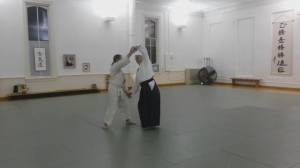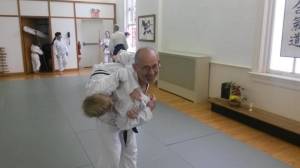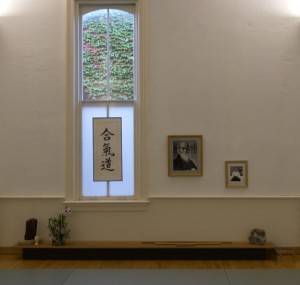If I asked you what was the first thing that came to mind when thinking about martial arts, what would you say? Karate, Kung Fu, Jackie Chan or Bruce Lee? Perhaps doing really impressive kicks in the air, or punching through a slab of concrete? Don’t get me wrong because that’s certainly what I used to think, but what if I asked you about the Japanese martial art Aikido, and the dojo currently operating in the Champaign-Urbana community. What would you think then?
Unfortunately, the majority of the time when I talk to people about Aikido the normal reaction is actually a lack of reaction, since many people have never heard of it or have an incomplete understanding of it and its philosophy. With that in mind, I’ll take you through a quick run through of Aikido and its history, as well as how it has been serving the Champaign-Urbana community through the Urbana-based dojo Central Illinois Aikikai, which has been putting the art back into martial arts for the past 40 years.

Aikido, which in Japanese means “the way of harmony with force and principle of nature”, was developed by Morhei Ueshiba, also known as O’Sensei or Great Teacher, in Japan during the mid-20th century in response to the brutal conflicts and violence of World War Two. Already an accomplished martial artist in various forms, Ueshiba declared Aikido to be a way of joining people around the world in peace, as a method for people to learn how to conquer themselves, not those around them. In Aikido practitioners don’t seek to dominate or beat an opponent. There aren’t any competitions or tournaments in Aikido, as the focus is for each individual to learn how to control their bodies and apply the techniques while working with a partner, instead of winning against a competitor.
Unlike other martial arts such as Karate, Tae Kwon Do, or Kung Fu that focus on hard strikes, Aikido relies on joint locks, pins and throws to neutralize an aggressor’s force with (ideally) the minimum amount of injury to both people. Because Aikido does not commonly use hard punches, kicks, or strikes, it has been sometimes called a “soft” martial art, though as a personal practitioner of Aikido I can guarantee that soft does not mean easy, nor any less effective.

I began practicing Aikido in High School, and once I moved to Champaign-Urbana for college I started practicing at Central Illinois Aikikai which is led by head instructor Knut Bauer, who has been practicing Aikido for over 35 years. “The first time I encountered Aikido was about 1977, and I’d never seen anything like it before” he explained.
“It began in 1974 as a University Club by Joseph Birdsong, and I practiced on and off till 1980 when he returned to Champaign-Urbana and asked if I wanted to start a new Aikido dojo with him. We were going to practice six days a week at 6am and 6pm, so we’d show up in the basement of Huff Gym twice a day and we’d normally have about 3-4 people show up for each class, and everything really grew from there. Our current dojo, the one in Urbana, is actually our fourth dojo and the third one I’ve built. We were able to make our current dojo come to life by a really generous donation from a past student, which allowed us to purchase our current space and then it took us about a year to re-build. We opened in 2003 and since then we’ve had our ups and downs, where at times we’ve had 50 to 60 students, and times where we’ve had 15 to 20 students. What’s amazing is we have people who are in their sixties and seventies still practicing Aikido, so people are continually evolving throughout their practice.
To me what makes Aikido unique is [that] one of our main purposes in coming to the dojo is also to learn how to become better human beings, and when you come to the dojo you have to leave everything else outside so that you can come and practice mindfully. I think the more that people come and practice it enables them to be more mindful in their everyday life and in everything they do. Aikido isn’t used just in the dojo, and it can help you see how your actions affect others around you. It really prepares you for everything that can come at you, and I don’t distinguish between being ‘inside’ and ‘outside’ the dojo, for me everywhere is the dojo”.
 Since I began practicing Aikido five years ago, one of the best things I’ve gotten from it are the incredible relationships I have formed. Amy Adams, who has been practicing at Central Illinois Aikikai since February 2004, has also had a very similar experience. “I am always amazed by the community and friendships that Aikido builds. It is an art based on the idea of harmony: with yourself, with other people, and with nature, even in the face of potential discord. You cannot simply do Aikido in a corner alone — you quite literally have to reach out to people from all different walks of life to learn and progress. Everyone has something to teach you. You learn to build trust, take risks, and rethink social interactions with the help of the other people”.
Since I began practicing Aikido five years ago, one of the best things I’ve gotten from it are the incredible relationships I have formed. Amy Adams, who has been practicing at Central Illinois Aikikai since February 2004, has also had a very similar experience. “I am always amazed by the community and friendships that Aikido builds. It is an art based on the idea of harmony: with yourself, with other people, and with nature, even in the face of potential discord. You cannot simply do Aikido in a corner alone — you quite literally have to reach out to people from all different walks of life to learn and progress. Everyone has something to teach you. You learn to build trust, take risks, and rethink social interactions with the help of the other people”.
 Building relationships, learning how to handle conflict both inside and outside of the dojo, and increasing your overall awareness, to me, are all amazing and often times hard to find skills. We all work so hard to balance both our work lives and personal lives, but sometimes in that quest the very thing we’re striving for gets lost in the process. Practicing Aikido at Central Illinois Aikikai has helped to improve not only my martial arts ability, but also on how to take those skills and apply them to my everyday life. A martial art should not only be teaching you how to fight and defend yourself, but it should also be teaching you how to live, and anyone who is looking for a way to combine both of those would do well to begin their search at Central Illinois Aikikai.
Building relationships, learning how to handle conflict both inside and outside of the dojo, and increasing your overall awareness, to me, are all amazing and often times hard to find skills. We all work so hard to balance both our work lives and personal lives, but sometimes in that quest the very thing we’re striving for gets lost in the process. Practicing Aikido at Central Illinois Aikikai has helped to improve not only my martial arts ability, but also on how to take those skills and apply them to my everyday life. A martial art should not only be teaching you how to fight and defend yourself, but it should also be teaching you how to live, and anyone who is looking for a way to combine both of those would do well to begin their search at Central Illinois Aikikai.








